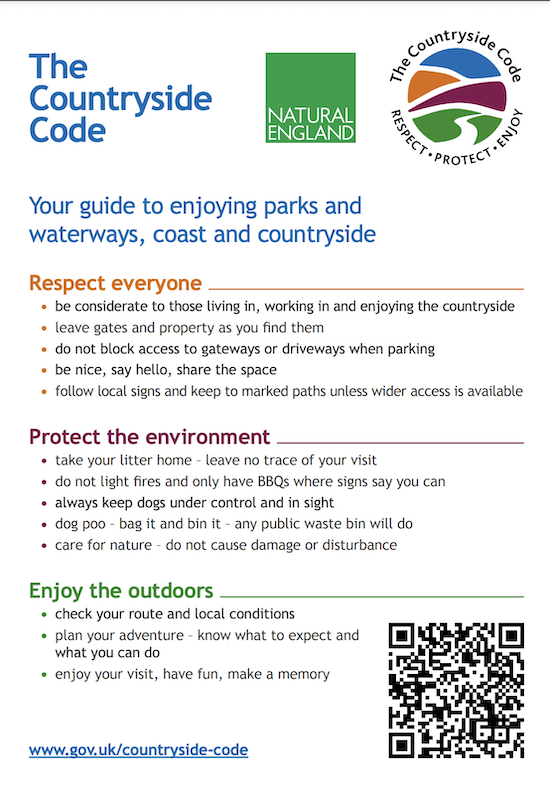 |
A guide to public rights of way signs
Rights of way (ROW) are footpaths, bridleways and byways which have public access. They are protected by law. The following are the signs you should look out for and what they mean in terms of your rights and those of the landowners. The information below is taken from the Hertfordshire County Council Rights Of Way guide.
- Public footpath
- Public bridleway
- Public restricted byway
- Byway Open To All Traffic
- Permissive Paths
- Unclassified Unmetalled County Road (UCR)
- Reporting a blocked ROW
- The Countryside Code
Hertfordshire County council has two map formats showing the public rights of way. One is a Geographic Information System (GIS) map with data, and the other is a Google map. Both can be accessed here.
Public Footpath
- You have the right to walk together with any ‘normal accompaniment’ (e.g. a dog, pram, wheelchair).
- You do not have the right to use a bicycle, or even to wheel a bicycle along them. This is not a criminal offence, but a trespass against the landowner.
- It is a criminal offence to drive a motor vehicle along a public footpath (unless you have a private right).
- You do not have the right to ride or lead a horse or take a horse-drawn vehicle along a footpath, although it is not a criminal offence.
Public Bridleway
- You have the right to walk along them, to ride or lead a horse and to drive animals. You may also cycle along them (this right was granted under the Countryside Act 1968).
- Cyclists must give way to walkers and horse riders.
- It is a criminal offence to drive a motor vehicle along a bridleway.
- You do not have the right to take a horse-drawn vehicle along a bridleway, although it is not a criminal offence.
Public Restricted Byway
- Restricted Byways carry footpath and bridleway rights and may also be used by horse drawn carriage vehicles but not motor vehicles, motor bikes etc.
- Restricted Byway is a new type of right of way which was introduced by the Countryside and Rights of Way Act 2000 and brought into force by the Natural Environment and Rural Communities Act 2006.
- As a result 'Roads Used as a Public Path' have now been re-designated as Restricted Byways.
Byway Open To All Traffic (BOAT)
- BOATs carry footpath, bridleway and vehicular rights. They are normally unsurfaced.
- They carry identical public rights to surfaced country lanes but they are, by definition, used mainly by walkers and riders.
- A BOAT’s surface is maintained to a standard consistent with its usage. The law applies to BOATs in the same way as an ordinary public road - any vehicle must be fully taxed, have an MOT certificate, and be insured. The driver must hold the appropriate driving licence. As a driver/rider you must also exercise the same level of care towards other users.
Permissive Paths
- Permissive routes can be used by permission of the landowner. They are the responsibility of the landowner to maintain.
- Routes with permissive rights may or may not be signed accordingly.
- Permissive routes have no legal status and the landowner can remove the permission at any time.
- Permissive rights may exist over a public right of way, i.e permission for horse riders to use a footpath.
- The County Council is not responsible for permissive routes.
Unclassified unmetalled county road (UCR)
 |
An 'unclassified unmetalled county road' (unclassified UCR or UUCR) is part of the highway but is not included within Hertfordshire's definitive map and statement of public rights of way. Unclassified unmetalled county roads are included within this data for the convenience of the Rights of Way Service.
The term 'county road' was introduced by the Local Government Act 1929, when county councils inherited responsibility for all roads in rural district council areas and classified roads in municipal boroughs and urban district councils. It was later made redundant by the Local Government Act 1974, but the term is still commonly used by highway authorities. The Planning Inspectorate consistency guidelines state that 'unclassified county road' has no legal standing but it carries some inference that the public may use the highway with vehicles.
Reporting a blocked ROW
The Hertfordshire County Council's ROW team has set up an excellent system for reporting issues with ROWs. You can report a blockage, encroachment, damage, and flooding. Just go to this page then report the details and the local ROW officer will look into it.
The Countryside Code
The government has published The Countryside Code which sets out the "responsibilities for visitors to the countryside and those who manage the land". It's worth reading to understand both your rights and how you are expected to behave when enjoying in the countryside.
 |
 |







